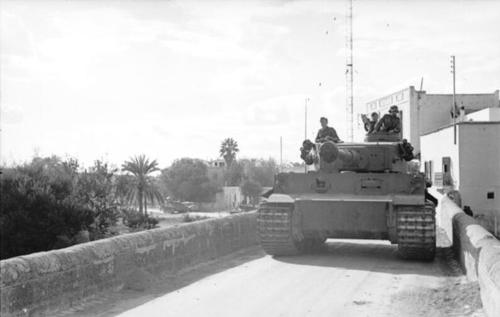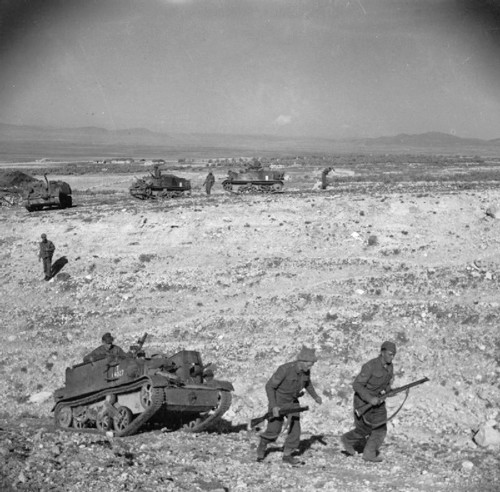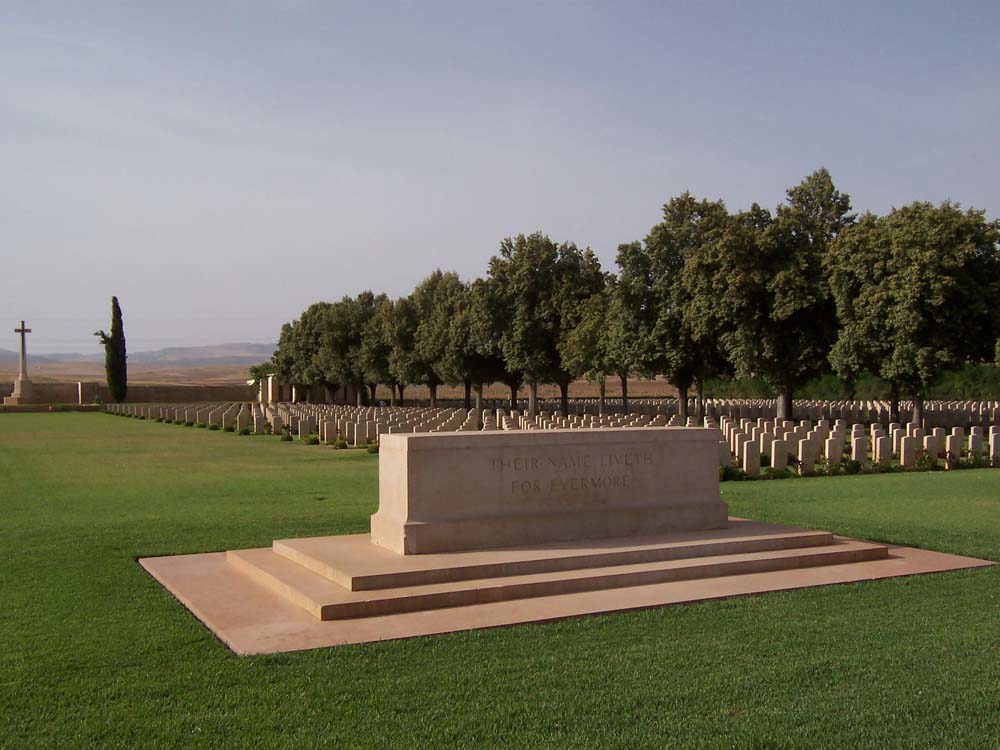14 November 2022
Endgame in the Desert: The Medjez-el-Bab Memorial & The Tunisia Campaign
The Battle of El Alamein marked the end of the beginning. The Tunisia Campaign finished the war in the desert. Read the story of the Medjez-el-Bab Memorial and the men it commemorates here.
The Tunisia Campaign

Gordon Highlanders advance in Tunisia (© IWM NA 1049)
The Medjez-el-Bab Memorial
Medjez-el-Bab, also known as Medjez-al-Bab, has a long, storied past.
Its roots go back beyond the Roman Empire, its magnificent hauonet sepulchral rock tombs dating back to the time of Numidians.
The site is no stranger to battles either. Back in the dying days of ancient antiquity, the great Byzantine general Belisarius defeated the rebel Stotzas near the then-village in 536 AD.
Medjez-el-Bab is significantly more peaceful today. The town of 22,000 inhabitants sits some 63.5 km southwest of Tunisia’s capital Tunis. The Medjerda River winds its way through Medjez-el-Bab on the way to the Mediterranean as the town’s people peacefully go about their lives.
Head around 5 km to the west of the town, however, and you’ll find a reminder of a time when this part of the world was far from peaceful.
Medjez-el-Bab War Cemetery holds nearly 3,000 Commonwealth burials of World War Two. The men buried here represent casualties sustained in Algeria and Tunisia as the Allies sought to bring a close to the war in North Africa.
A further 2,000 or so men are commemorated on the panels of the Medjez-el-Bab Memorial. These are those that fell during Algerian and Tunisian campaigns but have no known grave.
Why is there a war memorial in Medjez-el-Bab?
The cemetery and memorial at Medjez-el-Bab were built to commemorate casualties taken during fighting in and around Tunisia.
Campaigning took place there starting in late 1942 up until May 1943. By this stage, the Allies had finally forced the surrender of the Axis forces in North Africa.
Casualties commemorated at Medjez-el-Bab reflect service people who fell during the Tunisia Campaign and the final seven months of the North African conflict.
Operation Torch & the prelude to Tunisia

American troops wade ashore near Algiers during Operation Torch (Wikimedia Commons).
Victory at El Alamein in early November 1942 turned the North African tide after British General Bernard Montgomery managed to finally pin down and defeat German Field Marshall Erwin Rommel.
For years Rommel, known as the Desert Fox, had outfought and outmanoeuvred the Allies in Libya and Egypt. El Alamein stopped that.
The stage was set for the advance into Tunisia to finally bring an end to the North African conflict.
With the British Eighth Army pushing into Libya following the El Alamein victory, attention for American, Free French and other British troops turned further west.
An immediate amphibious landing to capture Tunis was ruled out early on. The Axis air forces of the German Luftwaffe and Italian Regia Aeronautica controlled airfields on Sardinia and Sicily. Both islands were far too close to Tunis and thus presented a major threat to naval forces.
Landings in Morocco and Algeria instead were decided upon. Allied planners thought that they would be able to capture some vital Mediterranean ports to support their logistics, then sweep across both nations into Axis-held Tunisia.
On 8th November 1942, Operation Toch was launched.
This was a three-pronged assault by American, Free French and British forces to capture Casablanca in French Morocco and the Algerian ports of Oran and Algiers.
At the time, these strategically important locations were held by the Vichy French. Around 125,000 or so Vichy troops were stationed in Morocco and Algeria, alongside hundreds of aircraft, tanks, and artillery pieces.
Although they met some stubborn resistance in some areas, the Torch landings were a success.
Naval bombardments and skirmishes helped bring about victories at Casablanca and Oran. The French Resistance aided the invasion too, helping sabotage artillery emplacements up and down the Moroccan and Algerian coast.
By 10th November, Torch had reached its objectives. The Allies had gained an important foothold in North Africa and three important ports.
A deal cut with American General Dwight D. Eisenhower and Vichy French General Francois Darlan freed the Vichy troops from their Axis obligations on the 22nd of November 1942. This essentially brought the French forces in North Africa over to the Allied side.
Axis forces build up in Tunisia
 Image: A fearsome German Tiger Tank of rolls through a Tunisian village (Wikimedia Commons).
Image: A fearsome German Tiger Tank of rolls through a Tunisian village (Wikimedia Commons).
On 9th November 1942, Axis forces began to strengthen in Tunisia.
Like Morocco and Algeria, Tunisia was a French possession at the time.
German forces moved quickly. Admiral Esteva, the French Governor of Tunisia, had refused to shut his nation’s airfields to either the Allies or Axis. Thus, the Wehrmacht was able to take control of the deep-water port at Tunis.
This meant it could move in men and materiel from Italy. Axis shipping could travel at night away from the predations of the Royal Air Force and its allies. Hitler believed Tunis could hold indefinitely.
By the end of November 1942, the Germans had managed to land three whole Divisions at Tunis. They were joined by two further Italian divisions.
By November 22nd, the Axis under Wehrmacht General Walther Nehring had assembled a full Corps, outnumbering the attacking Allies.
The Run for Tunis
 Image: Troop movements during the Run for Tunis (Wikimedia Commons).
Image: Troop movements during the Run for Tunis (Wikimedia Commons).
The race to secure Tunisia’s capital and chief port began in earnest in mid-November.
A straight landing at Tunis was ruled out due to a lack of troops and the threat of Axis aircraft from Sicily and Sardinia.
After the success of Torch, the Allies had begun capturing key ports and airfields along the Algerian coast. Three important locations were seized by 13th November.
As there were only two real roads into Tunisia from Algeria, the Allies planned to use them. Allied forces would drive up each highway and capture Tunis as well as the port of Bizerte.
Two Allied columns began the push into Tunisia, harassed by the Luftwaffe, but managed to progress on the northern route to their targets until November 17th. A force of 17 German tanks, 400 fallschirmjäger paratroopers, plus artillery, held up the attacking British troops for nine days.
Towards the south, Blade Force from the 6th armoured regiment, made of tanks and armoured vehicles, rampaged through gaps left in its accompanying infantry brigades. The tanks caused havoc and outflanked the Germans to attack an airfield at Djedeida, around 30 km from Tunis.
The defending Axis troops were gradually pushed back. On 26th November, the 11th Infantry Brigade entered Medjez-el-Bab unopposed, its German defenders pulling back to Djedeida.
Torrential rainfall had put paid to the Allied advance on the northern road to Bizerte.
By 1st December, the Axis forces had begun to counterattack. A planned Allied attack by Blade Force did not occur. Plans to drop 2nd Battalion, Parachute Regiment to attack airfields near Tunis were cancelled too.
10th Panzer Division, fresh into Tunisia, led the Axis counterattack. Blade Force sustained heavy casualties and withdrew on 2nd December.
 Image: Universal Carriers and British troops march through the desert (Wikimedia Commons)
Image: Universal Carriers and British troops march through the desert (Wikimedia Commons)
Desperate fighting by several Allied infantry units managed to hold up the German advance for four days but they were eventually forced to move to defendable high ground 30 km further from Tunis at Tebourba.
Across those four days, the 2nd Battalion, Hampshire Regiment took 75% casualties. The 1st Battalion, East Surrey Regiment also suffered 60% casualties. Fighting was fierce.
Eventually, the Allies were forced back to a defendable location called Longstop Hill a further 9.7 km from Tebourba.
An Allied counterattack was planned for late December. A force of 128,500 British, American, and French troops was assembled to push onward and clear the Tunis corridor. It wasn’t to be.
Despite lack of air cover and heavy rain, the initial advance showed progress. The initial approaches to Longstop Hill had been taken and by the 23rd, the Coldstream Guards had pushed back 10th Panzer back off the summit.
These gains were quickly reversed. A German counterattack retook Longstop Hill. Ammunition and supplies were running low. Longstop was becoming untenable. On 25th December, the Allies were forced to withdraw to Medjez-el-Bab.
Medjeb-el-Bab’s cemetery and memorial mark the limit of the Allied advance during the Race to Tunis.
The Axis had managed to stop the Allied advance in 1942. If they thought they could hold out indefinitely, they were quite mistaken.
Final Allied victory in North Africa
 Image: A British tank oversees surrendering German prisoners (Wikimedia Commons).
Image: A British tank oversees surrendering German prisoners (Wikimedia Commons).
In Libya, to the east of Tunisia, Erwin Rommel was being pushed back by Eight Army and Bernard Montgomery. By 17th February 1943, Rommel had sent men into Tunisia to occupy areas around the crucial Kasserine Pass.
With Montgomery’s capture of Tripoli in Libya, Rommel had to switch his main supply port to Tunis. Keeping his supply lines open was crucial. Kasserine Pass was a vital link in this chain.
On 19th February, Rommel, who had taken command of the 10th and 21st Panzer Divisions, launched an attack on the Kasserine against the US army troops defending the pass.
The Germans rolled through the pass and swept aside the inexperienced and poorly equipped American defenders.
The Allies managed to counterattack on February 22nd, but the American defenders had taken around 7,000 casualties.
This caused a complete reorganisation and reequipping of the Allied forces. Coordination between the different various British and American commanders had been poor during most of 1942 and joint operations. This was quickly remedied.
Kasserine was Rommel’s final victory of World War Two.
The British Eighth Army was beginning to push up from Libya through southern Tunisia. In March, Rommel threw his men into an attack on the northernmost British outpost of their southern drive at Medenine.
Rommel flew to Ukraine to try to talk Hitler into abandoning Tunisia. Hitler refused, withdrew Rommel from his command and replaced him with Arnim as the North African commander.
From March to April, the Allies would tighten the noose around the remaining Axis forces in North Africa. Continued attacks combined with an increasingly desperate supply situation meant the situation was quickly becoming untenable for the Axis.
On the 7th May 1943, the ports of Tunis and Bizerte were finally captured.
On 12th May, the Axis forces finally surrendered.
The battle for Tunisia and the whole of North Africa was, at last, an Allied victory.
Stories from soldiers commemorated at Medjez-el-Bab
Everyone commemorated at our Medjez-el-Bab sites made the ultimate sacrifice and we’re truly humbled by it. Some service personnel, however, performed actions above and beyond the call of duty.
Such actions earned several casualties here some of the British Army’s highest military honours. Often, this involved putting themselves directly in the line of fire with a low disregard for their own personal safety.
Take Lieutenant Roderick John Fraser of the Seaforth Highlanders.
 Image: Lieutenant Roderick John Fraser (marms, Find a Grave)
Image: Lieutenant Roderick John Fraser (marms, Find a Grave)
Lieutenant Fraser’s earned the Military Cross for his actions rescuing the wounded Private B. Campbell from under heavy machine gun fire during an action around Hunt’s Gap around Medjez-el-Bab.
The citation for Lieutenant Fraser’s medal reads: “During an attack at Hunt’s Gap on 3rd March 1943, Lieut. Fraser’s platoon supported the rest of Y Company up onto a hill and then moved up on the right to assist.
“When the company ran out of 2” mortar smoke, the company commander decided he could advance no further under the heavy fire and consolidated a position behind a ledge of rock, with the object of holding the ground they had gained.
“Lieut. Fraser then crawled with his company commander into the open in an endeavour to rescue Private B. Campbell who was lying there badly wounded. It was necessary to drag the Private in by his legs, and over rocky ground, this took half an hour.
“During that time Lieut. Fraser was under fire from an enemy machine gun which was sited to fire down on his position. During this operation, and the remainder of the action, Lieut. Fraser showed great coolness and disregard for his own personal safety.
Lieutenant Roderick John Fraser was killed aged 30 on 23rd April 1943.
Another decorated casualty commemorated at Medjez-el-Bab is Lieutenant-Colonel John Young Elphinstone Myrtle.
He was awarded the Distinguished Service Order for his part in organising resistance and an orderly withdrawal at Sedjenane, Tunisia with his battalion of the King’s Own Scottish Borders.
“For outstanding leadership and devotion to duty at Sedjenane on 2/4 March 1943 in command of his battalion which was ordered to defend that place,” Lieutenant-Colonel Myrtle’s medal citation states.
“During this period Lt Col. Myrtle’s battalion was attacked by approx. three battalions supported by artillery on three occasions on 3rd March, during the night ¾ March, and again on 4th March.
“During the whole operation, Lt Col. Myrtle showed outstanding leadership in his handling of the battalion, and it was largely due to this and his personal example that the battalion fought so magnificently.
“When ordered to withdraw, owing to greatly superior forces threatening his flanks and rear, Lt Col. Myrtle organised a withdrawal in daylight with great skill, getting out most of his weapons and the wounded.”
“Although wounded in the arm, he remained until he was satisfied that the withdrawal of his battalion was satisfactorily carried out.”
Unfortunately, the King’s Own Scottish Borders would be robbed of Lt Col. Myrtle’s leadership as he was killed on the 22nd of April 1943.
Discover the casualties of Medjez-el-Bab
Our Find War Dead tool allows you to discover the casualties we commemorate at Medjez-el-Bab and our other North African sites.
Simply add the “Country (Commemorated In)”, “Cemetery or Memorial”, and “Second World War” fields to enhance your search.
What stories will you uncover?






